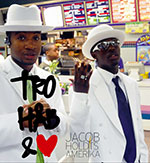|
|
Foreword
by Poul Erik Tøjner
Faith,
Hope and Love – Jacob Holdt’s America is an ongoing drama of
humanity and society. It consists of pictures from the past 40 years
of Holdt’s life – images of big city people in the rough ghettos,
drug addicts on the streets, the poor in their apathetic loneliness,
the well-heeled in their despondency, the sick with no money for
health care, the white, the black and the hungry. But love, hope and
faith in the future are depicted too – the heart is the watermark in
Holdt’s photographic project. This is about the Americans, but it is
also about you and me. About people, about being human and about
looking at the other and being with the others.
The social impulse makes Holdt’s work an important human suite even
before it is given a political address. Holdt is a photographer and
storyteller – far more in tune with literary realism and the
documentary gaze than with the more formal experiments of the
history of photography. For him the images are nothing without the
narrative, without the human beings at whose lives we, the viewers,
are looking.
In this catalogue we have gathered together three authors, each of
whom has been struck by Jacob Holdt’s multi-faceted American
pictures. The three essays take different routes into the core of
the oeuvre. The artist Erik Steffensen, who gave the Louisiana the
idea for the exhibition and, with his enthusiastic veneration for
the pictures, has been its midwife along the way, brings home to us
the things that are particularly true of Holdt’s work, viewed as
art; the prizewinning English novelist and photography expert Geoff
Dyer turns the spotlight on Holdt’s pictures as photographs both
like and unlike the work of other photographers, and situates the
Danish photographer in a prominent place in the history of
photography; while the American law professor Sandra Ruffin, who as
a young student at Harvard met Holdt on a tour of the USA, talks
about how the oeuvre has played and continues to play a role as a
socially and politically motivating factor for black Americans.
Holdt’s pictures do not have the smooth appeal of the advertising
aesthetic – perhaps even barely live up to today’s standards of
technical perfection. If the pictures are nevertheless outstanding
photographs – crucial testimony with social and thus political
power, which for a while can transport the viewer into the space of
reflection that is called art – this is because of a specific
praxis, which for Jacob Holdt is unlikely to have begun as a
photographic praxis, but which in reality became one. On his first
tour of the USA at the beginning of the 1970s the young minister’s
son from Ribe set out not only to get within shooting range of his
subjects, but also to be in there with his subjects. In the early
years, in every place where Holdt was invited in as activist-errant
and curious conquistador, he came to his hosts and their world – and
thus to the subjects of the photographic saga on which he soon
embarked – as a friend of the family, someone who looked
sympathetically and as an insider, so to speak, at people and
conditions.
As will be evident from the long interview Holdt has given for this
book, the distinctive objective vulnerability to be found in his
pictures arose as a result of cultural and social differences so
obvious that the best will in the world could not deactivate them.
In other words, the differences generate awareness. Emotionally,
they are no obstacle but a bridge for Holdt.
The viewer is free to step on to this bridge – and yet not quite
free, perhaps. For is it not the case that these very pictures by
Holdt affect us in a special way? They are hard to look away from,
you almost feel obliged to look at them – even though, given Holdt’s
strong desire to show human, personal life in all its forms and
nuances, they sometimes show us things we decidedly do not like to
look at. On this issue the late American writer Susan Sontag wrote
so aptly in the book Regarding the Pain of Others that we have
considered it essential to draw attention to the essay once more by
reprinting an extract.
Holdt is able to convey via the camera all the circumstances that
crowd in on the lives we see with a low-key, sensitive rendering of
empathy. It is the ambition of the exhibition to guide the viewer
into Jacob Holdt’s universe – shaped as it is by an indignation, an
empathy and a sure artistic eye for the good picture without which
it would all lose itself in well-meaning triviality.
For the Louisiana an exhibition of Jacob Holdt’s work is a logical
step along the path exploring the surrounding world that is the
overall aim of the museum’s activities, culturally, aesthetically,
socially, whether the medium is art, architecture, music or the
living word. A museum of modern art must have an active metabolism,
a permanent succession of exchanges not only with the disciplines of
art (insofar as these exist at all in pure form) but also with the
world around us. Jacob Holdt – whom we cordially thank for his
commitment, his pictures and his will to place his (lifelong)
American project in the hands of the Louisiana and thus the many
people who visit the museum – is a very fine example of this.
Poul Erik Tøjner
Director
Copyright © 2014
AMERICAN PICTURES
Index
|
|
